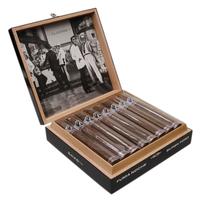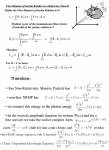G'day folks
I have a question that has been rattling around this empty head for a while and I have been unable to find any relevant info that will help.
I drill vulcanite rod on a pillar drill but rather than chuck the bit, I chuck the rod and have a chucked jig on the table holding the bit stationery. As I'm sure lathers will know, this acts to pull the bit into the center of rotation and thus centers fairly impressively. Now I'm making a few assumptions about the physics at play that I'm not qualified to make, but my understanding is the spinning rod is subject to centripetal/centrifugle (can't remember which) force which effectively pushes the rod away from the center of rotation. When the bit makes contact with the rod, an equal and opposite force pulls it into the centre of rotation. Assuming this is correct, the greater the force acting on the rod (i.e. the faster the rod is rotated), the greater the force acting on the bit. And therefore, in theory, the more RPMs, the greater the benefit of this
centering action. But of course, you can't just crank the drill into overdrive without melting the bit into the vulcanite.
My primary objective is to establish a spin rate that maximizes the centering without creating too much heat. I appreciate that it is a lot more complicated than that since bit diameter,feed speed, technique etc. all need to be taken into account, but I'm looking for a ballpark figure - a starting point. So my question is: what is the general consensus on RPMs when drilling vulcanite rod?
But I'm also interested to know if this centering is something that you pro lathers consider when establishing chuck RPMs, or do you just calculate speed based on material and bit diameter and consider any centering an added bonus. I have done some experiementation and have found that you can crank it up fairly high without burning the rubber if your technique is sound, and that there is very little difference in cut quality between a hole drilled at 400 RPMs and a hole drilled at 1300 RPMs.However, I'm (figuratively) burning through a heck of a lot of rod.
I apologise if I have articulated this question in a completely arse-about-face fashion, but from a centering perspective, it seems that faster is better if you can keep the heat down, but I can't help feeling that I am missing something major. (I use sharp 9/64 split-point ti coated Dormer bits.)
Many thanks folks.
Geoff
I have a question that has been rattling around this empty head for a while and I have been unable to find any relevant info that will help.
I drill vulcanite rod on a pillar drill but rather than chuck the bit, I chuck the rod and have a chucked jig on the table holding the bit stationery. As I'm sure lathers will know, this acts to pull the bit into the center of rotation and thus centers fairly impressively. Now I'm making a few assumptions about the physics at play that I'm not qualified to make, but my understanding is the spinning rod is subject to centripetal/centrifugle (can't remember which) force which effectively pushes the rod away from the center of rotation. When the bit makes contact with the rod, an equal and opposite force pulls it into the centre of rotation. Assuming this is correct, the greater the force acting on the rod (i.e. the faster the rod is rotated), the greater the force acting on the bit. And therefore, in theory, the more RPMs, the greater the benefit of this
centering action. But of course, you can't just crank the drill into overdrive without melting the bit into the vulcanite.
My primary objective is to establish a spin rate that maximizes the centering without creating too much heat. I appreciate that it is a lot more complicated than that since bit diameter,feed speed, technique etc. all need to be taken into account, but I'm looking for a ballpark figure - a starting point. So my question is: what is the general consensus on RPMs when drilling vulcanite rod?
But I'm also interested to know if this centering is something that you pro lathers consider when establishing chuck RPMs, or do you just calculate speed based on material and bit diameter and consider any centering an added bonus. I have done some experiementation and have found that you can crank it up fairly high without burning the rubber if your technique is sound, and that there is very little difference in cut quality between a hole drilled at 400 RPMs and a hole drilled at 1300 RPMs.However, I'm (figuratively) burning through a heck of a lot of rod.
I apologise if I have articulated this question in a completely arse-about-face fashion, but from a centering perspective, it seems that faster is better if you can keep the heat down, but I can't help feeling that I am missing something major. (I use sharp 9/64 split-point ti coated Dormer bits.)
Many thanks folks.
Geoff










